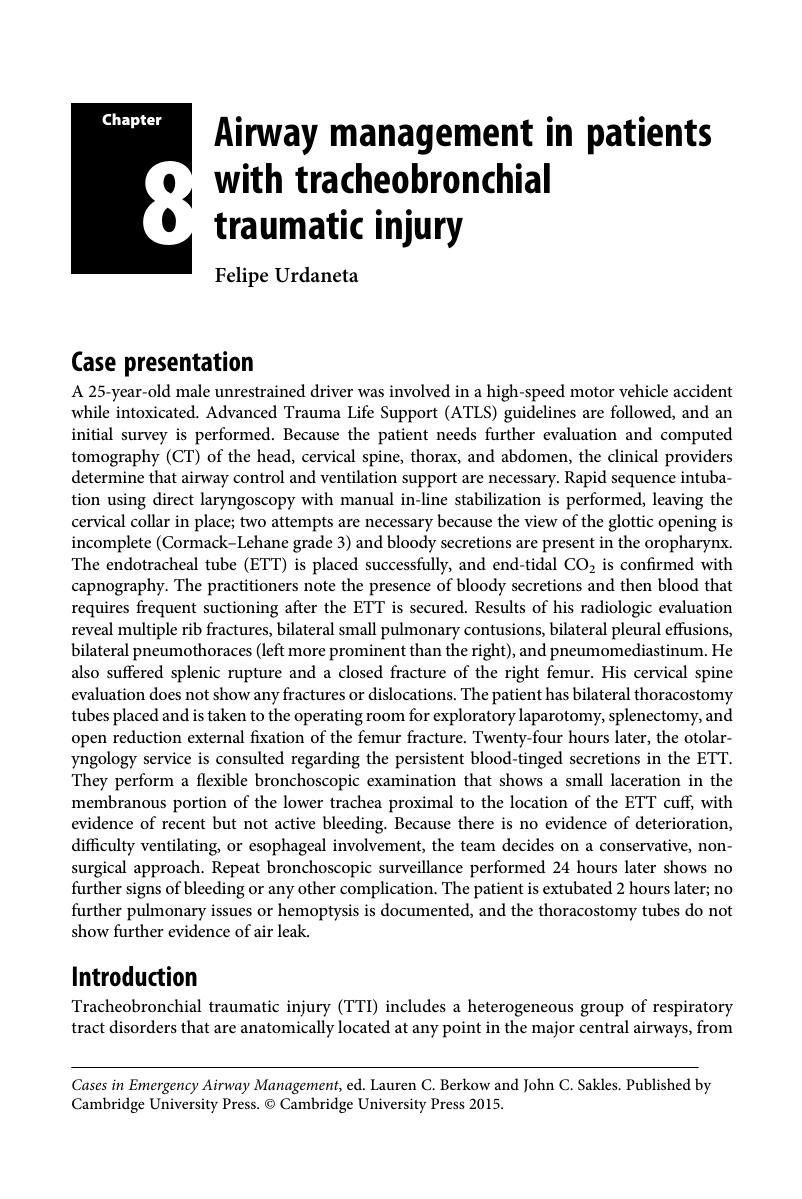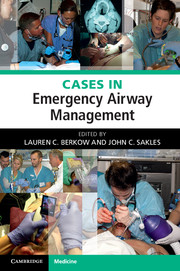Book contents
- Cases in Emergency Airway Management
- Cases in Emergency Airway Management
- Copyright page
- Contents
- Contributors
- Preface
- Chapter 1 Anatomic consideration for airway management
- Chapter 2 Airway algorithms and guidelines
- Chapter 3 A general approach to evaluation and management of the emergency airway
- Chapter 4 Management of patients with angioedema
- Chapter 5 Stridor due to upper airway obstruction/mass
- Chapter 6 Tracheostomy-related airway emergencies
- Chapter 7 Subglottic airway emergencies
- Chapter 8 Airway management in patients with tracheobronchial traumatic injury
- Chapter 9 Airway management of the patient with morbid obesity
- Chapter 10 Adult and pediatric epiglottitis
- Chapter 11 Management of foreign body aspiration in pediatric and adult patients
- Chapter 12 Management of anterior mediastinal mass
- Chapter 13 The asthmatic crisis
- Chapter 14 Airway management ofthe pregnant patient
- Chapter 15 Management of patients with laryngospasm
- Chapter 16 Airway compression by expanding hematoma
- Chapter 17 Extubation of the difficult airway
- Chapter 18 Management of blunt and penetrating neck trauma
- Chapter 19 Airway management of patients with smoke inhalation
- Chapter 20 Airway management in cervical spine injury
- Chapter 21 Airway management in facial trauma
- Chapter 22 Airway management in head injury
- Chapter 23 Airway management of pediatric congenital anomalies
- Chapter 24 Management of post-tonsillectomy hemorrhage
- Chapter 25 Fiberoptic intubation
- Chapter 26 Video laryngoscopy for emergency intubation
- Chapter 27 Surgical airway management
- Chapter 28 Communicating airway information: difficult airway letters and the MedicAlert National Difficult Airway/Intubation Registry
- Index
- References
Chapter 8 - Airway management in patients with tracheobronchial traumatic injury
Published online by Cambridge University Press: 05 December 2015
- Cases in Emergency Airway Management
- Cases in Emergency Airway Management
- Copyright page
- Contents
- Contributors
- Preface
- Chapter 1 Anatomic consideration for airway management
- Chapter 2 Airway algorithms and guidelines
- Chapter 3 A general approach to evaluation and management of the emergency airway
- Chapter 4 Management of patients with angioedema
- Chapter 5 Stridor due to upper airway obstruction/mass
- Chapter 6 Tracheostomy-related airway emergencies
- Chapter 7 Subglottic airway emergencies
- Chapter 8 Airway management in patients with tracheobronchial traumatic injury
- Chapter 9 Airway management of the patient with morbid obesity
- Chapter 10 Adult and pediatric epiglottitis
- Chapter 11 Management of foreign body aspiration in pediatric and adult patients
- Chapter 12 Management of anterior mediastinal mass
- Chapter 13 The asthmatic crisis
- Chapter 14 Airway management ofthe pregnant patient
- Chapter 15 Management of patients with laryngospasm
- Chapter 16 Airway compression by expanding hematoma
- Chapter 17 Extubation of the difficult airway
- Chapter 18 Management of blunt and penetrating neck trauma
- Chapter 19 Airway management of patients with smoke inhalation
- Chapter 20 Airway management in cervical spine injury
- Chapter 21 Airway management in facial trauma
- Chapter 22 Airway management in head injury
- Chapter 23 Airway management of pediatric congenital anomalies
- Chapter 24 Management of post-tonsillectomy hemorrhage
- Chapter 25 Fiberoptic intubation
- Chapter 26 Video laryngoscopy for emergency intubation
- Chapter 27 Surgical airway management
- Chapter 28 Communicating airway information: difficult airway letters and the MedicAlert National Difficult Airway/Intubation Registry
- Index
- References
Summary

- Type
- Chapter
- Information
- Cases in Emergency Airway Management , pp. 56 - 62Publisher: Cambridge University PressPrint publication year: 2015



